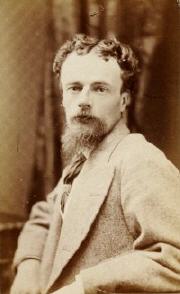
John Atkinson Grimshaw was a Leeds painter of landscapes, town views and dockyards, especially at sunset or by moonlight. His most frequent subjects were towns and dockyards in London, Liverpool, Leeds, Glasgow, Scarborough and Whitby.
The subject matter of Grimshaw’s paintings was innovative. Night scenes, lit by moonlight, reflected on wet cobbled streets where horse-drawn traffic moved, wraithlike, through the mists; dockyard scenes with the spiky outlines of the ships’ masts rearing up against a darkening sky, hansom cabs and people scurrying through rain swept streets lit by a golden flow from the shop windows; rural lanes flanked by sad, leafless trees – it was from such unlikely subjects as these that Grimshaw extracted his unique form of poetry.
The son of an ex-policeman, Grimshaw began painting whilst he was working as a clerk for the Great Northern Railway and encountered great opposition from his parents. He painted mostly for private patrons and by 1870 he was successful enough to rent Knostrop Old Hall where many of his paintings now hang.
Grimshaw's landscapes are permeated with photographic vision, with their mists, the stencilling of branches or masts against a moonlit sky, the reflections of light on water and dark, smudgy figures that seem like shapes that have moved on a time-exposed photograph. He managed to sustain a deeply poetic imagination until the end of his life. His scenes of urban and rural lanes, and the nocturnal views of Greenock and Liverpool, are a powerfully evocative Victorian extension of the “moonlight Pether” tradition.
The artist exhibited at the Royal Academy between 1874 and 1886 and also at the Grosvenor Gallery.